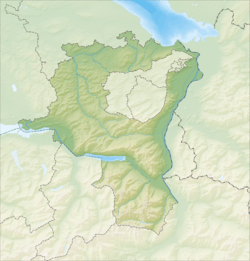Niederbüren facts for kids
Quick facts for kids
Niederbüren
|
||
|---|---|---|

The Sorntal Textile Museum
|
||
|
||
| Country | Switzerland | |
| Canton | St. Gallen | |
| District | Wil | |
| Area | ||
| • Total | 15.84 km2 (6.12 sq mi) | |
| Elevation | 488 m (1,601 ft) | |
| Population
(Dec 2020 )
|
||
| • Total | 1,507 | |
| • Density | 95.14/km2 (246.41/sq mi) | |
| Postal code |
9246
|
|
| Surrounded by | Bischofszell (TG), Gossau, Niederhelfenschwil, Oberbüren, Waldkirch | |
Niederbüren is a small town, also called a municipality, in Switzerland. It is located in the canton of St. Gallen, within the Wil area, which is like a voting district.
Contents
History of Niederbüren
Niederbüren has a long history! It was first mentioned in old writings around the year 737. Back then, it was known as Gaulichesburia. Later, in 817, it was called ad Purias, and by 1266, people referred to it as Nidernburron.
Where is Niederbüren Located?
Niederbüren covers an area of about 15.8 square kilometers (which is about 6.1 square miles). A big part of this land, about 66.1%, is used for agriculture, like farms. Forests cover about 24.1% of the area. The rest of the land, about 8.6%, has buildings and roads, while a small part (1.2%) includes rivers or lakes.
The town is situated in the Wil area. The main village of Niederbüren is on the right side of the Thur River. There are also smaller villages, called hamlets, in the nearby hills.
What Does the Coat of Arms Look Like?
The blazon (official description) of Niederbüren's coat of arms is quite unique. It shows a golden beehive with bees on a blue background at the top. Below that, on a silver background, there are three red stripes.
Who Lives in Niederbüren?
As of 2023, Niederbüren has a population of about 1,500 people. A small part of the population, about 5.7%, are people from other countries. Most people in Niederbüren (95.0%) speak German. Other languages spoken include Serbo-Croatian and Turkish.
Age Groups in Niederbüren
In 2000, the population of Niederbüren included:
- About 18% were children aged 0 to 9 years old.
- About 16.7% were teenagers aged 10 to 19.
- About 10.7% were young adults aged 20 to 29.
- About 17.9% were adults aged 30 to 39.
- About 15.1% were adults aged 40 to 49.
- About 8.8% were adults aged 50 to 59.
- About 5.7% were seniors aged 60 to 69.
- About 4.8% were seniors aged 70 to 79.
- About 2.2% were seniors aged 80 to 89.
- A very small number (0.1%) were over 90 years old.
How People Live Together
In 2000, about 6.8% of people lived alone. About 14.6% were couples without children. The largest group, about 74%, were couples living with their children. A smaller group, about 3.3%, were single parents.
Education in Niederbüren
Many people in Niederbüren have a good education. About 74.2% of adults (aged 25–64) have finished either high school or gone on to higher education, like a university or a specialized college.
Population Changes Over Time
Here's how the population of Niederbüren has changed over many years:
| year | population |
|---|---|
| 1798 | 947 |
| 1850 | 1,181 |
| 1900 | 1,038 |
| 1950 | 1,135 |
| 2000 | 1,414 |
Important Buildings and Sites
Niederbüren has some special places that are considered important national heritage sites in Switzerland. These include:
- The Textile Museum in Sorntal.
- A historic house located at Staatsstrasse 35.
What is the Economy Like in Niederbüren?
In 2005, many people in Niederbüren worked in the primary economic sector, which means jobs like farming. There were 78 businesses in this area. The secondary sector, which includes manufacturing and construction, employed 391 people in 22 businesses. The tertiary sector, which includes services like shops and offices, had 153 people working in 35 businesses.
Many people who live in Niederbüren also travel to other towns for work. In 2000, about 438 residents worked outside Niederbüren, while 358 people came into Niederbüren for their jobs.
Religion in Niederbüren
Based on a census from 2000, most people in Niederbüren are Roman Catholic, making up about 67.5% of the population. About 18% belong to the Swiss Reformed Church. There are also smaller groups of people who belong to the Orthodox Church or other Christian churches. About 2.4% of the population is Islamic. Some people do not belong to any church, or are agnostic or atheist.
See also
 In Spanish: Niederbüren para niños
In Spanish: Niederbüren para niños






